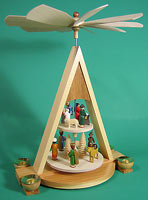Do German Pyramid Levels Have Significance
Do German Pyramid Levels Have Significance?
 German pyramids have been a Christmas tradition for over three centuries in Germany and the tradition has been spreading throughout Europe, America, and the rest of the world ever since. Germany is responsible for creating, advancing, or promoting the majority of the Christmas traditions that we all celebrate in today. The Germans were the first to place Christmas trees in their homes as a symbol of their faith in Christianity, advanced the idea of decorating the Christmas tree by producing ornaments and candy decorations, and they promoted the idea of a jolly elf who flies around the world on Christmas Eve leaving children presents and goodies to open on Christmas Day. All of these Christmas traditions started as a way to celebrate and honor the birth of Jesus and their faith in the Christian faith.
German pyramids have been a Christmas tradition for over three centuries in Germany and the tradition has been spreading throughout Europe, America, and the rest of the world ever since. Germany is responsible for creating, advancing, or promoting the majority of the Christmas traditions that we all celebrate in today. The Germans were the first to place Christmas trees in their homes as a symbol of their faith in Christianity, advanced the idea of decorating the Christmas tree by producing ornaments and candy decorations, and they promoted the idea of a jolly elf who flies around the world on Christmas Eve leaving children presents and goodies to open on Christmas Day. All of these Christmas traditions started as a way to celebrate and honor the birth of Jesus and their faith in the Christian faith.
The German pyramid is no different. In fact, the earliest German pyramids were mostly decorated in Christian inspired stories from the Bible. As German pyramids became more and more ornate and developed into a treasured German Christmas tradition, handmade figurines that were made to decorate the pyramids began to tell more complex biblical tales. German pyramids were originally made by miners from the Erzgebirge mountain region of northeastern Germany. During the cold and brutal winter months, the villages of the area were completely cut off from the rest of the world. To keep busy, miners and their families worked on traditional arts and crafts that were handed down from generation to generation. These crafts included woodcarving, glassblowing, blacksmithing, and a variety of other artistic methods. As a result, the area began producing quality arts and crafts pieces that were sold throughout Germany and eventually around the world. This included German pyramids, smokers, nutcrackers, cuckoo clocks, Christmas ornaments, and figurines.
These crafts were almost always decorated in either religious or wildlife related themes. The German pyramid had a unique advantage when it came to storytelling, however, over the other German crafts that were produced in the area due to their overall size and whimsical movements. Complex storylines could be told on a German pyramid which would come to life with multi-dimensional animation and light. Because of the unique design of German pyramids, large multi-tiered platforms could be stacked on top of each other and allow a different part of each story to be told. As the heat from the candles would rise, causing the wooden fan above to spin, the figurines within the German pyramid would turn, bringing to life the characters that lived inside.
 The most popular story that is told in a German pyramid is by far the story of the birth of Jesus. In homes across Germany, families would place their German pyramids out on a table or next to the Christmas tree and parents would teach their children the Nativity Story by using the pyramid as a visual tool. Because of their unique design, German pyramids can have both moving parts and stationary parts. When telling the Nativity Story, many German pyramids will place the baby Jesus in the center of the pyramid, generally on the middle tier, as a stationary figure. This symbolizes the importance of the Christ child as all the other characters spin around him in adoration. Depending on the size of the German pyramid, one or more parts of the story can be told. In three, four, and five tiered pyramids, more complex storylines can be told. Each story is usually told from the bottom tier to the top tier and very specific portions of the story are told on each level. For instance, in the Nativity Story, the bottom tier of the German pyramid might tell of the journey of Mary and Joseph to Bethlehem and their stay in the manger. Another tier might represent the shepherds and the Three Wise Men making their way to see the Christ child and spreading the word of the birth of the Savior to the world. The top tier might show the angels in heaven rejoicing at the birth of Jesus and spinning around the top as they play harps, trumpets, and bells. At the very top, near the spinning fan, there might also be a single star, representing the star of Bethlehem guiding the searching shepherds and wise men to the stationary Christ figure directly below. With the candles glowing, the wheel spinning, and the characters coming to life within the German pyramid as the story was being told, you an imagine how wonderful a sight it must have been for the children hearing the story for the very first time.
The most popular story that is told in a German pyramid is by far the story of the birth of Jesus. In homes across Germany, families would place their German pyramids out on a table or next to the Christmas tree and parents would teach their children the Nativity Story by using the pyramid as a visual tool. Because of their unique design, German pyramids can have both moving parts and stationary parts. When telling the Nativity Story, many German pyramids will place the baby Jesus in the center of the pyramid, generally on the middle tier, as a stationary figure. This symbolizes the importance of the Christ child as all the other characters spin around him in adoration. Depending on the size of the German pyramid, one or more parts of the story can be told. In three, four, and five tiered pyramids, more complex storylines can be told. Each story is usually told from the bottom tier to the top tier and very specific portions of the story are told on each level. For instance, in the Nativity Story, the bottom tier of the German pyramid might tell of the journey of Mary and Joseph to Bethlehem and their stay in the manger. Another tier might represent the shepherds and the Three Wise Men making their way to see the Christ child and spreading the word of the birth of the Savior to the world. The top tier might show the angels in heaven rejoicing at the birth of Jesus and spinning around the top as they play harps, trumpets, and bells. At the very top, near the spinning fan, there might also be a single star, representing the star of Bethlehem guiding the searching shepherds and wise men to the stationary Christ figure directly below. With the candles glowing, the wheel spinning, and the characters coming to life within the German pyramid as the story was being told, you an imagine how wonderful a sight it must have been for the children hearing the story for the very first time.
Another popular story that has been told in a well designed German pyramid is the story of Adam and Eve. In fact, this is thought to be one of the earliest stories represented in the first German pyramids that were built in Germany. Most German people celebrate Advent, which is the month long period before Christmas Eve. This typically begins the Christmas season celebrations and many German families will traditionally bring out their German pyramids and light the candles at the beginning of Advent to signal the start of the holiday season. The story of Adam and Eve is said to have formed the German pyramid into its multi-tiered shape of story telling as its shape was said to symbolize the Tree of Knowledge as it stood in the Garden of Eden. These German pyramids would typically tell the story of Good and Evil from the bottom tier to the top and usually contained a ball or apple at the top symbolizing the forbidden fruit. Many times, children would make their own small decorations to hang on the German pyramids themselves or add flowers, greenery, tinsel, or candy to them. While some families could not afford to buy a Christmas tree or ornaments each year, they almost always had their own German pyramid and would use it as the central piece in their holiday decorations. These were often referred to as the "poor man" Christmas tree as a result.
Today, German pyramids are still used and displayed throughout Germany as a symbol of Christmas. As German settlers moved throughout the world and to the United States, they brought with them their Christmas traditions, including their German pyramids. In addition to the religious stories that are told in the traditional German pyramid, there are also a variety of other stories that are told, including ones of German life, nature, and other popular Christmas themes. However, the stories are all told in very much the same way as they are with the religiously themed German pyramids, from the bottom to the top with lights, animation, and whimsy.
